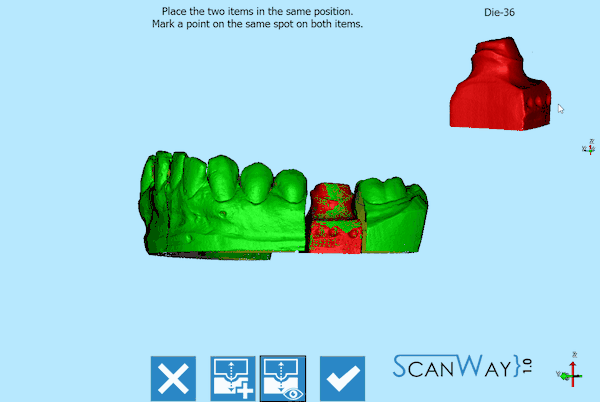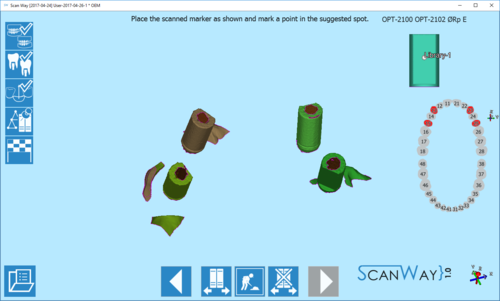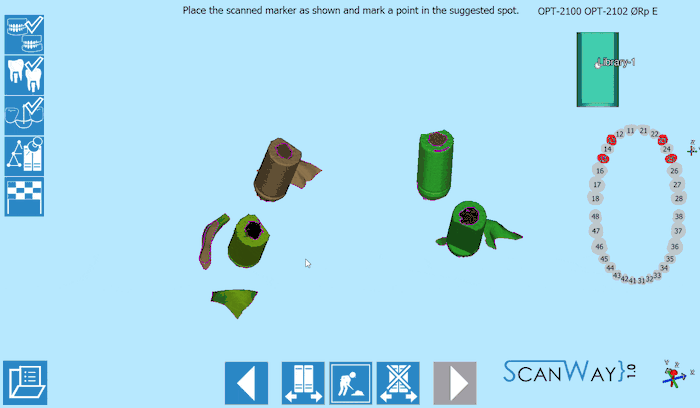Difference between revisions of "Align/pt-br"
(Created page with "{{Screenshot|selec_biblioteca.png}}") |
(Created page with "O Painel está dividido em 4 Seções:") |
||
| Line 53: | Line 53: | ||
| − | + | O Painel está dividido em 4 Seções: | |
;Library: For choosing the general connection and implant family, contains: | ;Library: For choosing the general connection and implant family, contains: | ||
Revision as of 07:49, 29 June 2017
Contents
Alinhamento Geral
O alinhamento é uma etapa intermediária que muitas vezes passa despercebido, pois é quase sempre automático. Na verdade, quando o alinhamento automático for bem-sucedido, o usuário verá apenas uma janela de verificação de alinhamento.
A janela de verificação de alinhamento mostra todos os itens alinhados em cores diferentes e uma barra de ferramentas específicaː
- 40px Anterior
- volta para a etapa anterior. Ícone não ativo durante a primeira etapa de escaneamento.
- 40px Fixar Alinhamento
- mostra uma lista dos itens alinhados para permitir ao usuário consertar um deles, caso ele seja incorreto.
- 40px Avançar
- Avança uma etapa no projeto. Esta opção não está disponível até que todos os itens tenham sido identificados e separados
Ao clicar no botão x25px, a lista de itens alinhados é mostrada.
Ao clicar em um dos itens alinhados, o painel de alinhamento manual se abre para permitir ao usuário corrigir o alinhamento realizado automaticamente.
Na etapa de alinhamento manual é mostrado, no centro da janela, o elemento fixo ou de referência ao qual o item detalhado será alinhado; no canto superior direito, o item flutuante ou em movimento que será combinado com a referência; uma barra de ferramentas específica.
 Sair
Sair- sai da seção Opção.
- 40px Melhor ajuste
- corrige o alinhamento entre as duas imagens. Essa ação geralmente é automática.
- 40px Vista flutuante
- mostra ou oculta a imagem do item flutuante / móvel.
 Aceitar
Aceitar- Aceita as alterações e fecha a seção de opção.
Para realizar o alinhamento, coloque as duas imagens (fixas e em movimento) na mesma posição e marque um ponto no mesmo ponto de ambos os itens. Se necessário, devido a combinações difíceis ou falta de informação, é possível colocar vários pontos nas imagens.
Aceite ou cancele as alterações para continuar com o projeto.
Scanbodies para Implantes
Ao escanear os dados para um projeto sobre implantes, o escaneamento do próprio implante é problemática. Não é como um munhão ou um modelo de gesso. As conexões / interfaces do implante são normalmente pequenas e metálicas.
Além disso, o encaixe deve ser mecanicamente perfeito, sem margem de erro.
Para resolver este problema, a conexão do implante não é escaneada diretamente, mas um Marcador de Implante ou Scan Body 'é usado em vez disso. Um Scan Body é um objeto específico, projetado para ser escaneado, que se encaixa exatamente sobre o implante.
O escaneamento do próprio scan body não é suficiente: os dados resultantes serão usados para calcular a posição exata da interface do implante. Para realizar esta operação, é necessária uma Biblioteca de Implantes.
O alinhamento para a biblioteca de implantes pode ser realizado no software CAD. No entanto, usando uma biblioteca de implantes para a Plataforma do Exocad, o usuário pode executar esta operação diretamente no software de escaneamento ScanWay, para obter melhores resultados
Seleção da Biblioteca
A seleção da biblioteca de implantes é exibida automaticamente quando todos os itens do projeto foram escaneados.
O Painel está dividido em 4 Seções:
- Library
- For choosing the general connection and implant family, contains:
- A Filter box where it is possible to write part of the name of the needed implant. All the implants that match the name will be showed in the implant list
- An implant list with all the implants available in the current Implant Library
- Type and Sub Type
- For Choosing the diameter and type of connection. There can be many of these types, in our libraries for instance there are:
- Engaging Connections : the connection can not rotate on the implant, suggested for abutments or single restorations
- Not-Engaging Connections : the connection can rotate on the implant, suggested for bars and bridges
- For Zirconia : connections with specific shapes, suited for zirconia restorations
- Preview
- Shows the preview of the STL marker present in the library
- Info
- If the library is correctly configured to work with our software, in this section it is possible to have a small overview of the libraries with additional information on the availabe diameters and implant types.
All our libraries are provided with this feature and, being connected to this wiki, the Open in browser button opens the wiki on the implant list page.
To accept the implant selection click on Select, otherwise Cancel.
If the CAD design is launched using a wrong connection it will be necessary to restart all the design from the beginning
Marker Alignment
Once the library has been selected, the wizard shows the marker alignment step.
The interface shows all the acquired markers; an image of the STL of the library with a premarked point; a teeth graphic showing the elements that need to be aligned; a specific toolbar.
The toolbar offers this options:
 Previous
Previous- Goes back to the previous step. Icon not active during the first scanning step.
 Change implant library
Change implant library - Allows to change implant library, for instance if in one case have been used different connections.
 Show model
Show model - Shows or hides the reference model underneath the markers.
 Reset
Reset- Restarts the alignment from the beginning.
 Next
Next- Goes forward one step in the project. This option is not available until all the items have been aligned.
To align it is simply necessary to move the scanned markers to mimic the position of the library STL shown in the upper right corner of the window. When the marker is in the correct position ,mark one point as suggested in the library image. Repeat for all the acquired elements, not necessarily following any order.





